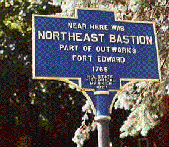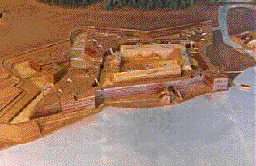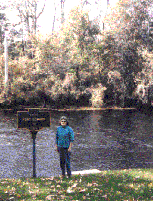Footsteps Through Time | Home
The War With King Philip | The French and Indian Wars | The Revolutionary War | The Civil War | The Dakota Territory | The World Wars
The French and Indian Wars 1756


Fort Edward, New York 1756
French and Indian War
Nathaniel Peck served with the Rhode Island Provincials from May 1755 to December of 1755, and again from February 1756 to his death on August 24, 1756 at Fort Edward.
Battle of Lake George.
In the scheme of grand strategy of the British ministry the movement planned against Crown Point was hardly successful, though it was marked by one of the most important engagements in the war, the Battlle of Lake George. Here, the colonial troops under their own officers and with their own organizatio, accomplished the memorable defeat of the French and Indians under Baron de Dieskau. Colonel William Johnson, a notable figure in the Mohawk Valley of New York, was appointed major-general.
Crown Point is situated on the western side of Lake Champlain, a strategic position guarding access to several New England States.The French were building fortifications there, and were posing a great threat to the English settlements.
On the first of January, 1755, Rhode Island voted to raise a company of 100 men for the emergency. In February, the number was increased to 113. By March, it was voted that four companies of 100 men each be raised to take part in a secret expedition to Crown Point. Christopher Harris was appointed Colonel of the regiment.
The Rhode Island Regiment under Harris marched to Green-Bush near Albany, where their boats were caulked and their guns cleaned and mended.
Albany was selected as the rendezvous, and the troops from the different colonies gathered there. About the first of August, Major-General Lyman led the advance up the Hudson River and commenced building a large fort, first named Fort Lyman, afterwards, Fort Edward, in honor of Edward, brother of George the Third, and a few days later, General Johnson left Albany with the remained of the troops, artillery, and stores, accompanied by King Hendrick and his Mohawk warriors.
A report reached the General that the French were concentrated at Fort St. Frederick (Crown Point) with an army of six thousand mend. They intended to continue on to Fort Ticonderoga to fortify it. General Johnson reached there first with fifteen hundred men on the 28th, rechristened the lake in honor of his Majesty George, and asserted his right of dominion there.
On the third of September, Baron de Dieskau, Commander of the French forces in Canada, moved down from Fort St. Frederick to Ticonderoga to begin work on the line of fortifications, which he purposed establishing southward. When he heard of the building of Fort Lyman (Edward), he at once embarked with a detachment of two hundred and sixty French Grenadiers, eight hundred Canandians, and seven hundred Indians, sailing down Lake Champlain in canoes to South Bay, then marching across the country, encamping within a league of Fort Lyman. This was the 7th of September, and he intended to surprise the fort the next day. The Indian chiefs were called together to be informed of the plan of attack and to be assigned positions. After consultation among themselves, the Iroquois, numbering 300, would not join in the attack. The rest of the Indians also refused to take part. The reason given that they had resolved not to act against the English on their own territory. They did agree to go against the English camp at Lake St. Sacrament. So, the French moved on to the lake. After marching some hours, a prisoner was taken who stated that General Johnson had heard of the contemplated attack on Fort Lyman, and that he had detached one thousand men who were on their way to reinforce it. Dieskau at once ordered the Canadians to move forward about three hundred paces on the right, and there to lie flat on the ground. He ordered the Indians forward to take a similar position on the left, holding back the French regulars in the center. No gun was to be fired until the English had reached the end of the cul de sac and then the volley from the French in front was to be supplemented by the fire from the Indians and Canadians on either flank, close to the rear, leaving no escape for the English.
General Johnson's forces in the camp consisted of about 3000 provincials and 250 Indians. Early in the morning of the eighth of September a Council of war was called, rumors having reached the camp of the proposed attack on Fort Lyman. It was not known exactly where the French were, but it was proposed to send a force of five hundred men to the assistance of the Fort. Hendrick was consulted and replied: "If they are to fight they are too few, if to be killed they are too many." The number was doubled. General Johnson then proposed to divide the forces into three parties. Hendrick thereupon picked up several arrows, and handing one of them to General Johnson saying, "Put them together and you can't break them; take them one by one and you will break them easily." Hendrick's argument was convincing.
(These arrows are shown in the Lake George Memorial of the Society of Colonial Wars where are figures of Sir William Johnson and Chief Hendrick
Attack on Fort Lyman
Colonel Ephraim Williams was placed in command of the troops and they set out in two divisions, Colonel Williams leading the first, Lieutenant-Colonel Whiting the second. King Hendrick on horseback at the head of a band of two hundred and fifty Mohawks, preceded the provincials.
They proceded to Rocky Brook, where the French and Indians lay awaiting them. Knowing nothing of the change of plans of the French, whom they supposed near Fort Lyman, they sent out no scouts, but marched directly into the death trap. An accident only saved them. Some of the Senecas, with the French forces, espying their Mohawk brethern fired their muskets into the air as a warning of the ambuscade. Then the war-whoop sounded, followed by a discharge of musketry from behind rocks and trees. Colonel Williams at once spread out the men on the hill to the right, and took up a position on the rock on which now rests his monument. He soon fell, and almost at the same time Hendrick's horse was shot from under him, and being unweildly he could not recover himself, and was stabbed to death with a bayonet.
Lt. Col. Whiting Assumes Command
Lieutenant -Colonel Whiting succeeded to the comand. He saw the danger of his men and immediately ordered a retreat, which he conducted so skillfully that he saved the greater part of his force. The noise of the firing was heard at Lake George, and General Johnson dispatching Lieutenant-Colonel Cole with three hundred men to support and protect the retreat, set to work with the utmost vigor with all his remaining forces to construct defences for his camp, preparing breastwork of felled trees and wagons,and hauling up and placing in position such cannon as he had to cover the river road and approaches.
It had been Dieskau's purpose to rush forward and enter the camp of the fugitives; but the Iroquois took possession of a rising ground and remained inactive. The other Indians also halted, and a few shots from the cannon soon drove them all to cover in the swamps at either side, and left the French Commander and his veteran regulars unsupported. As the regulars advanced, they halted suddenly about one hundred and fifty yards from the breastworks, trying to call the Indians to their aid. Failing in this, they again advanced, firing by platoons.
Early in the battle, General Johnson received a wound in the thigh, and retired to his tent, the command then devolving upon General Lyman, who behaved with great bravery.
The fire from the French made but little impression, while the artillery under the command of Captain Eyre, played upon them with great effect. Dieskau, finding it impossible to break the centre, moved to the right, and attacked the regiments under Colonels Ruggles, Williams and Titcomb. The three regiments resisted the attack resloutely and maintained a hot fire upon the enemy. At foru o'clock in the afternoon, about seven hours after the attack in the morning, the Colonial troops, inspired by the thought that victory was theirs jumped over the breastworks with their Indian allies, and charged upon the French, who precipitately retreated, leaving most of their troops dead upon the field. Some prisoners were taken by the Colonials, including Baron Dieskau, who had been wounded. He was taken to General Johnson's tent, where only the General's great influence prevented his being seized by the Indians to expiate with fire the deaths of King Hendrick and the other Mohawk Chiefs.
The Mahican Channel, once the heart of Mohican country, was the primary route of travel from Albany to Montreal. This New York vein pulsates with the waters of the Hudson River, Lake George, and Lake Champlain. It was the strategic corridor that hosted the most intense struggles of the colonial wars. Second to the Hudson is the Mohawk River, its primary tributary. Flowing through the valley of central New York, south of the Adirondack Mountains, the Mohawk River traverses southeasterly until it unites with the great Hudson River, north of Albany. These two picturesque river valleys are marked by rolling hills, forests, creeks, lakes, farmland, and mountains. Both meander through a land of intense beauty!
Complimenting this gorgeous country is its rich history, perhaps an unparalled combination. Here amidst the splendor of wilderness, were the bloody battlefields and razed settlements, the seemingly unending string of outposts and fortresses. While the temptation to include photos and narratives of the many forts and battlefields of the entire Upstate New York country is hard to resist, and the region is a 'beautiful feature of war in the Americas', it is 'best to keep our sight fixed on our duty'! To that end, we must remain on the trail of the Mahican Channel.
At the location known as The Great Carrying Place - where the Hudson River, after escaping the Adirondack Mountains, bends sharply to the south, towards Albany and New York City beyond - a succession of posts and forts, ultimately to become Fort Edward, were to occupy the ground. It was a strategic place, as anyone using the great north/south waterway of the Hudson and the lakes to the north, George and Champlain, needed to travel from, or to, here by land. Thus, the name ... bateaux, canoes, supplies, all needed to be transported by carrying them. So, at the time, Fort William Henry stood at the northern end of the portage, the southern end of Lake George, while Fort Edward stood at the bend, the southern terminus ... a distance of approximately 17 miles.
Built in 1755, Fort Edward is most notable for its association with Robert Rogers and his Rangers. Adjacent to the Fort, on an island situated at the great bend in the Hudson River, was the base camp of Rogers' Rangers during the French and Indian War. There was on this site, named Rogers Island, a hospital, a blockhouse, barracks, and Ranger huts. A hub of activity throughout the French and Indian War, Fort Edward was abandoned in 1766 by the British when they removed themselves to Crown Point. Left in disrepair, the fort fell to ruin and no portion of the once crucial military base exists today.


Bloody Pond
At the southern end of Lake George, southeast of Fort William Henry, and three miles from the site of Fort George is a tranquil spot called Bloody Pond. The infamous name was borne of the Battle of Lake George in 1755.
In the summer of that year, Sir William Johnson headed an expedition through the Hudson Valley. Its objective was to capture Fort St. Frederic at Crown Point, the launching point for French and Indian raids into English frontier settlements. Johnson's forces included Provincials, as well as Mohawks led by the aged Thoyanoguen, also known as King Hendrick. A camp was established at The Great Carrying Place and construction of storehouses and a fort was begun. Johnson and 1,500 troops continued northward toward the lake. Arriving at Lac Du St. Sacrement on August 28, Johnson renamed the waters Lake George; a declaration of English possession.
As Johnson camped at the southern end of Lake George, preparing for the march against Crown Point, a French force led by Baron Dieskau was moving southward out of Crown Point; its destination was the new outpost under construction at The Great Carrying Place called Fort Lyman. On September 7, a party of Mohawk scouts arrived at Johnson's camp with news of the French movement southward. On the morning of September 8, a detachment of Provincial troops led by Colonel Ephraim Williams, along with 200 Mohawks led by Hendrick was sent to halt the French advance. Along the road from Fort Lyman to Lake George, the English troops marched into a well planned ambush. Both Colonel Ephraim Williams and King Hendrick were killed and the Provincial contingent was nearly wiped out. The inexperienced, panicked survivors retreated to Johnson's camp where preparations were immediately made for defense.
During the subsequent battle at the lake, both the English and French commanders were wounded. Dieskau angrily chided his Canadians and Indians, whom he thought too undisciplined, and the assault was carried on by the regulars. General Phineas Lyman assumed command of the English troops and though the French regulars kept up a persistent firing at the center of the English defenses, the distance was too far off. Lyman's troops drove the French from the battlefield by the afternoon and captured the wounded General Dieskau who was left behind by his forces.
Though the English were victorious, the loss of so many, especially Col. Williams and King Hendrick, stole the fire from their fight. Johnson abandoned the plan to advance against Crown Point, remaining instead at the lake. He renamed the Lyman fort at the bend of the Hudson River Fort Edward and commenced the construction of another fort that would two years later gain tragic infamy; Fort William Henry.
The four - times wounded Baron Dieskau, while a prisoner at the Lake George camp, became the object of Mohawk fury and English outrage. Grieved over the loss of King Hendrick and many warriors at the ambush, the Mohawks wanted to kill Dieskau and several times came close to doing so. The prisoner's life was protected by the intervention of William Johnson, but his honor was not. It was alledged that the French were firing poisoned musket balls and an angered General Lyman daily paraded past Dieskau's tent with reproaches and insults. According to the surgeon Thomas Williams, brother of the slain Col. Williams, the French musket balls had been "rolled up with a dissolution of copper and yellow arsenic."
Following the ambush and defeat of Colonel Ephraim Williams' detachment, many Canadians and Indians tarried to loot and scalp the corpses of the unfortunate Provincials and Mohawks. They tarried too long ... thus they were surprised and overtaken by more Provincial troops from Fort Lyman (Fort Edward). The bodies of the slain Canadians and Indians were said to have been tossed unceremoniously into the nearby pond. The bloody sepulchre is no longer a pond, having been covered with sawdust from a local sawmill. What is marked as "Bloody Pond" today is not the actual pond of battle fame.
(Note: Major George Bray has pointed out that not only is the town's reference to the existing pond as "Bloody Pond" incorrect, the nearby plaque mounted on the rock erroneously states the Battle of Lake George to be Robert Rogers' first engagement. The famous ranger was not present at the battle.)
Captain Nathaniel Peck
Massachusetts Militia
1756

Fort Edward
New York